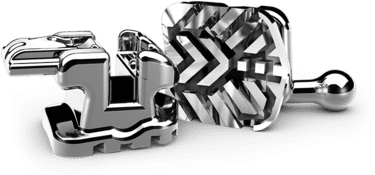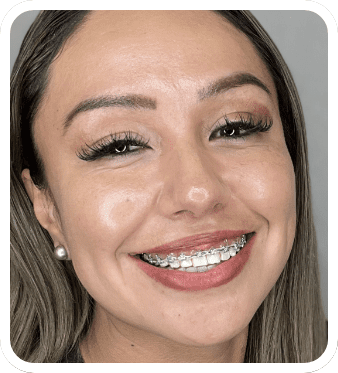

The Pitts21 is an advanced, low-friction, light force orthodontic solution that delivers healthy tooth movement with optimal control. Pitts-trained orthodontists are visual artists who design customized patient smiles. These smiles are more than just straight teeth; they are remarkable.
Comfortable CareWith the Pitts21™ system, the smooth rounded corners and edges of the braces are soft against your lips, creating a more comfortable experience. The low-profile design of the braces makes them protrude less, reducing irritation.
Other orthodontists may rely on outdated methods like expanders—techniques that date back to the 1970s. But why settle for uncomfortable and old-fashioned approaches? With the cutting-edge Pitts21™ system, expertly mastered by Dr. Herman, you’ll enjoy both exceptional results and a more comfortable journey to your wide, beautiful smile.
Shorter AppointmentsThe Pitts21™ system of braces also operates more efficiently than traditional braces resulting in shorter appointment times.
SpeedPitts21™ braces have been carefully designed to give orthodontists the best opportunity to move teeth as fast as possible. This typically results in fewer appointments and faster treatment time than traditional braces.
HygieneThe small size and rounded edges make Pitts21™ braces easy to clean. A quick swish with water will free most food from your braces.
Quality ResultsThe Pitts21™ system allows for healthy tooth movement and complete control of the finished alignment. Once treatment is done, patients leave our Farmington orthodontist office with wide beautiful smiles and straight teeth.

Your braces will be attached quickly and easily to your teeth, but a full day is necessary for the bands to completely affix. It is a good idea to wait several hours after getting braces before eating solid food. You may find it easier to eat soft foods for the first couple of days while you are becoming accustomed to eating with your new braces.
The braces may feel a little awkward at first, and the teeth may be tender or sensitive to pressure. This is completely normal and will go away soon. It may feel as though the braces are “sticking out,” but this sensation will also soon pass. Small pieces of orthodontic wax may be used if the brackets irritate cheek tissues. The orthodontic office always has extra wax in case you run out, so call them if you need more.
Many patients will experience some discomfort at first, but the soreness will go away within the first few days or even hours of getting braces. It is impossible to predict exactly when the tenderness will end. Some patients choose to take over-the-counter pain relievers the first day of treatment to lessen the discomfort. To ensure the best result, take the medications before your appointment.
Braces are attached to your teeth with a strong adhesive but may become loose as a result of eating certain foods. It is also possible that wires could become bent or broken without proper care. Since it is best to achieve orthodontic treatment goals with as few disruptions as possible, a well balanced diet is important to ensure a healthy environment for your teeth.
Patients should avoid foods that are sticky, hard, or chewy. They should also avoid any food and drinks that are known to cause cavities. Patients should brush, floss, and rinse their mouth regularly between meals. The foods below are known to cause breakage of orthodontic appliances.
Orthodontics is the area of dentistry concerned with the supervision, guidance and correction of the dentofacial structures. Orthodontic treatment uses braces, retainers and other appliances to correct any dentofacial abnormalities. Regular dental check-ups and orthodontic treatment are proven to be effective tools in helping establish and maintain good oral health for people of all ages. Braces can be beneficial to both children and adults. Orthodontic treatment will result in a beautiful smile that will impact your self confidence for years to come.
An orthodontist is a specially trained dentist who has attended an advanced education program for a continual training period of 2 to 3 years. All members of the American Association of Orthodontists (AAO) have received the appropriate training.
It’s never too late to have a beautiful smile! Adults can visit a Farmington, NM orthodontist to improve the appearance of their smile and their overall dental health at any time. Some orthodontic corrections need to be made as early as 3 to 5 years of age, but ordinarily children should visit an orthodontist at the time permanent teeth begin to erupt in order to detect any deficiencies in the child’s teeth formation. This is usually between 7 and 10 years of age. The American Association of Orthodontists recommends that children visit an orthodontist no later than age 7. An early visit may not result in children’s braces; however, Dr. Herman can monitor the growth and alignment of teeth and address any orthodontic problems as they arise.
Your initial visit to the orthodontist will give you an opportunity to meet the doctor and our knowledgeable staff, who will answer any questions you may have. You will receive a complimentary clinical examination and panoramic x-ray to determine whether orthodontic treatment is necessary. If treatment is required, Dr. Herman will go over a treatment plan as well as an estimate of the treatment duration. Your treatment coordinator will answer any questions you may have concerning insurance, and will go over our flexible payment options. In most cases our patients are given the option to start treatment the same day as the initial examination. Our patients appreciate the fact that we are able to do everything in one appointment, so there is less time away from work or school.
Braces may be worn by both children and adults, not only to improve the attractiveness of their smile, but also because braces correct improper alignment of teeth that can lead to gum disease and early tooth loss. Left untreated, crooked teeth with irregular spacing make cleaning harder and allow cavities to more easily develop. Properly aligned teeth also make it easier to chew all types of food, and eliminate the headaches and pain caused by uneven chewing. Uneven teeth may result in weak enamel, gum problems and jaw misalignment. Modern technology has resulted in numerous options of braces that will fit your specific lifestyle and will provide you more comfort during treatment.
Braces are lighter, more comfortable and more technologically advanced today than ever before. They come in clear and a variety of colors and material choices. Ask the office staff about what options are available. Other appliances include colorful bands, elastics and retainers.
Braces exert a gentle pressure on teeth over time to straighten them. The two main components include the braces placed on the teeth and the arch wire that connects them. The brace is a specially-shaped metal or ceramic affixed to each tooth and the arch wire is bent to reflect the bite that the patient should have after treatment. The wire threads through the braces and as the wire tries to return to its original shape, it applies pressure to move the teeth.
There have been some fantastic advances in modern orthodontics to make treatment more comfortable and quicker for patients. There are now smaller, smoother braces and gentler wires which provide a continuous small force over a long period of time rather than a strong force for only a short period. Typically there is some discomfort after the braces are first put on. Over the counter pain relievers and a soft foods diet will help alleviate this temporary discomfort.
You should be able to play just about any sport. However, it is recommended that you wear a mouth guard while participating in certain sports.
Retainers help keep your teeth aligned at the completion of treatment. If they are not worn as instructed, your teeth will move.
Treatment may last from 18 to 36 months, though this will vary depending on your individual case. Your cooperation in keeping scheduled orthodontic appointments, maintaining proper oral hygiene and taking care of your braces may allow you to finish your orthodontic treatment early.
You should continue to see your dentist or the Four Corners Hygiene department every 6 months or as directed during orthodontic treatment for routine dental checkups and cleanings.
PALATAL EXPANDERS: Dr. Herman believes expanders are outdated and has heard various complaints regarding palatal expanders because of excess pain, discomfort, and hygiene issues. Therefore, at Four Corners, we offer easier methods using the Pitts 21 System in order to achieve a similar result to the palatal expander.
If one’s treatment plan includes palatal expanders, we typically recommend getting a second opinion from a Pitts-trained orthodontist.
The Pitts 21 System of braces has very specific placement of braces on all teeth. Pitts trained orthodontists achieve wide, beautiful smiles because of the highly placed brackets (braces) on the upper front teeth. This placement is called the Smile Arc Protection Protocol, which creates more appealing, aesthetic results.
It is very difficult to receive a thorough cleaning with orthodontic wires in place. It is similar to taking a shower with undergarments on. You will miss some very important areas that need cleaning. We require a dental cleaning every six months while you are going through treatment to assist in keeping one’s gums, teeth and supporting bone as healthy as possible. In other orthodontic offices, oral health problems are a huge issue. At Four Corners, we do our best to minimize oral health issues by offering onsite dental hygiene and dental services. One-stop oral health care makes everything easier.
Like schoolwork, rubber band wear is a team project with a child. We typically start rubber band wear the first day braces are placed. The staff explains to the patient why and how rubber band wear is a big part of treatment. Rubber bands are used to prevent tooth extractions and the use of a palatal expander, decrease a patient’s time in treatment, or to correct a bite, etc. Following a thorough explanation of the importance of rubber bands, our patients usually accept the responsibility for rubber band wear while having a parent involved to check in on the rubber band wearing process. Elastic wear is like homework to a child. We help the patient minimize the homework load whenever possible. This minimization can range from “nighttime wear only” to “no rubber bands vacation.
Dr. Herman and his staff share one’s concern about removable retainer wear. We are the only orthodontic practice in the Four Corner area that almost always places double retainers. We place a fixed or glued-on retainer to the back of both the upper and the lower front teeth. Following the placement, we require the patient wear a clear type of aligner over the teeth at bedtime. This double system allows patients to wear removable, clear, aligner retainers while sleeping only. Between the fixed, the glued-on, and the clear aligner retainers, patients have a greater chance of keeping straight teeth once braces are removed.
Invisalign is an alternative for patients wanting to correct crooked teeth. Similar to braces, there are pros and cons to getting Invisalign. Dr. Herman will consult and discuss if Invisalign can meet one’s treatment expectations.
If one decides to proceed with Invisalign, Dr. Herman recommends using the genuine product. If an orthodontist states, “aligners or aligner therapy,” but does not state Invisalign, then the orthodontist may be using an Invisalign-like aligner. We only provide aligners from Invisalign.